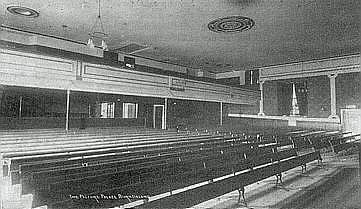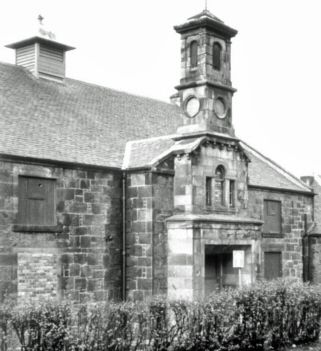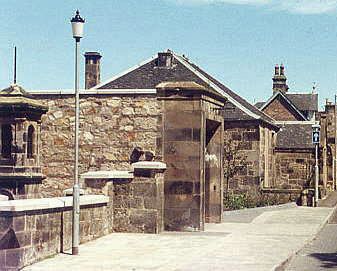The Palace Cinema
By the late Norman Mackie
Edit this text

Silent pictures were first shown in Burntisland early in the first world war at the Palace on the corner of the Kirkgate and East Leven Street. The Palace started life as a Church. This, after the Reverend David Couper and some of the congregation broke in 1843 with the Church of Scotland and, somewhat provocatively, built a rival church opposite the parish church. In 1860 they built a second church, St Andrew’s (also known as the Couper Church) in the High Street. The vacated Kirkgate building then became Frank Quarton's grain store before taking on a new life as the Palace with the introduction of silent pictures. (The interior of the old Palace cinema is pictured right.) Silent pictures on a large screen brought a new form of entertainment to the people of Burntisland. They came to see Douglas Fairbanks Senior and Mary Pickford, Pola Negri, Charlie Chaplin, Buster Keaton, Charley Chase, Our Gang, Harold Lloyd and many others. The sub titles, hard forms and tip-up seats, were accompanied by the music of a resident pianist and augmented on Friday evenings with a violinist and drums. Who can forget the adept musical improvisation of Mrs Fraser for funerals, horse racing and amorous love scenes? What of her ability to pluck a sweet out from her bag at the end of the keyboard without missing a note! Who can still remember singing to the words and following the bouncing ball or following the adventures of Tarzan of the Apes, Miracles of the Jungle, or Pearl White? Other acts also appeared live on stage, these included underwater antics in a large water tank, shooting gallery experts and many escapologists, including the famous Harry Houdini who made an appearance during his last world tour. Matinees were Wednesdays, 4 pm, and Saturdays, 2 pm, admittance to matinees were one old penny and twopence, evening shows were 6 pm and 8 pm. Close by were the sweetie shops, in this case Bisset (Bottler), Mrs Campbell in the Kirkgate, also Lows, High Street - the inevitable late closing on a Saturday evening providing the famous Lows boilings - twopence per quarter.
The Original Couper Church Building

The buildings adjoining the Palace are also of interest. The first Labour Exchange was in the annex behind Thistle Cottage and later in Leven Villa. Leven Villa was built on the Lammerlaws and then dismantled, stone by stone and completely rebuilt in the Kirkgate to allow the excavation of the Lammerlaws for the many rail tracks required on the East Dock. The house immediately across the street, now number 33, housed the first telephone exchange, and was operated by the Riley family. The Church also built the country school, now the derelict Leven Street Hall, adjacent to the Palace building. The school catered for children from the country and was on top of the steep incline from the foreshore, hence the Scholars' Brae.
In the mid '20s Mr Andrew Maxwell, the manager of the Palace, retired and the Palace closed as a cinema, giving way to its rival the Porte. After the Palace closed, the building lived on as a badminton, boxing and athletic club centre. Later the building was taken over by the late Mr James Ferguson who used it to store scaffolding, paint etc until, on the 28th September 1977, fire gutted the building closing 134 years of history. The façade is pictured below (left). The building was demolished, and today the site is a monumental garden marked only by the entrance and truncated bell tower of the original church. The picture below (right) shows - the bell tower; the entrance (centre); and the former Country School (centre right).
The Demolished former Couper Church/ Palace Cinema with the Country School in background


